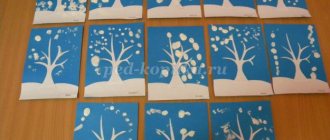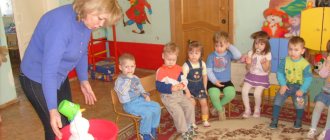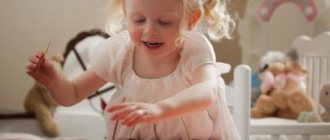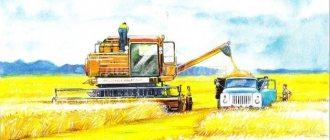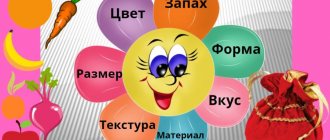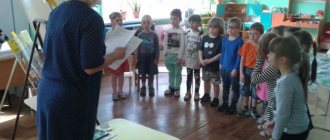Lesson summary for the junior group of the kindergarten “Winter Fun”
Summary of an open lesson in the junior group “Winter fun of Gnome Gnomych”
Author:
Natalya Anatolyevna Chigirina, teacher, GBOU School No. 1373, Moscow I offer a summary of educational activities on cognitive development.
This material will be useful to educators, children of primary preschool age and their parents. Goal: to clarify children’s ideas about winter fun. Objectives: - to develop thinking, attention, imagination; — teach how to perform breathing exercises; — form elementary mathematical concepts; - develop gross and fine motor skills; - develop the ability to work and play together. Types of children's activities: cognitive, productive, playful. Materials and tools: attributes for staging, Nikitin cubes; simulator for breathing exercises, “snow” balls, glue, paints. Methodological techniques: theatrical activities, physical education, finger gymnastics, productive activities.
Course of the lesson
Organizational moment Demonstration of the performance On the trees, on the alleys The snow flies whiter than flour, Light-light, clean-clean, Soft, fragile and fluffy. Snow is falling from the sky, the fairy tale begins! In a small hut on the edge of the forest lived a Gnome Gnomych. One day a dwarf went out onto the street, where you couldn’t see white everywhere. Snow decorates the trees, dressing them in white coats. Snow-white, light snowflakes are flying and circling around. Snowflakes sparkle in the sun, blinding your eyes. The gnome went for a walk in the forest. How nice it is in the forest in winter! Suddenly he sees a bunny sitting. He sits and is bored. The gnome asks: “Bunny, why are you sad?” “I’m bored,” says the bunny. - I do not know what to do. – Winter is the best time of year for fun! “Let’s build a snowman,” the gnome answered. “We’ve got a wonderful snowman, the snowman is just a sight for sore eyes,” says the bunny. – Doing something together is very pleasant and fun. I’ll run and tell my friends about the snowman. The bunny ran away, and Gnome Gnomych continued to walk through the forest. He goes and admires the winter beauty. Suddenly he sees a squirrel sitting. The dwarf asks: “Squirrel, why are you sad?” “I’m bored,” says the squirrel. - I do not know what to do. – Winter is the best time of year for fun! “Let’s play in the snow with you,” the gnome answered. They started having fun here, a real “battle” - a “battle” with snowballs. “Thank you, gnome,” says the squirrel. – It was a lot of fun to play. You came up with an interesting idea. I'll run and tell my girlfriends about it. The squirrel galloped away, and Gnome Gnomych went on for a walk through the forest. The little fox-sister is sitting here. - Little fox-sister, why are you sad? “I’m bored,” the fox answers. - I do not know what to do. – Winter is the best time of year for fun! “Let’s go sledding with you,” the gnome answered. “I don’t have a sleigh,” says the fox. The gnome ran to get the sleigh. They ride down the mountain on a sled with cheerful screams and laughter. “Thank you, gnome,” says the fox. – I really enjoyed sledding. - Come again. I know a lot of winter fun! Educator: Guys, Gnome Gnomych also invites us to a winter walk. Let's go for a walk. Physical exercise Look - there are white paths outside the window. Let's go for a walk anyway, stomp along the paths. Let's put warm boots on our feet, and warm mittens on our hands, little sisters. Educator: Put on your mittens quickly. And walk at least all day. Guys, lay out the cubes with the red (yellow, blue) color facing up. Then we put the cut out silhouette of the mitten and you will see a colored mitten. Working with Nikitin's cubes "Multi-colored mittens"
Educator: Now you and I are not afraid of any frost. Gnome Gnomych offers to play the Game “Winter Words.” If you hear words related to winter, then clap your hands. Snowflake, warmth, sled, ice, heat, mittens, chamomile, slide, New Year, snowman, falling leaves, Santa Claus, apples, Snow Maiden, sea, snowfall, skis, skates, frost. Educator: and now it’s time to make a snowman Finger game “Snowman” Tra-ta-ta, tra-ta-ta, Children are glad for the snow. - Let's clap our hands. Tra-ta-ta, tra-ta-ta, We are making a snowman. - Making snowballs. Let's put our fists on top of each other. Let's draw in the eyes and “draw” the eyebrows. Insert the nose with a carrot. - Two fists in front of your nose. Let's find the hat. - Hands above your head. That's what a snowman is, - Hands are placed on the shoulders - belt - 2 hits on the knees Snowy, white fatty! At the end - they puff out their cheeks, round their arms at the elbows, clasp their fingers in front of them, and spin around themselves. Educator: Our winter adventures continue. Let's build a snow fortress from lumps (big and small), selecting them according to size. Game “Snow Fortress” Musical accompaniment “Blizzard”
Light fluffs and white snowflakes fall from the sky in winter and circle above the ground.
Breathing exercise “Snowflakes” Educator: Guys, you need to inhale air through your nose, make your lips a tube, exhale through your mouth without puffing out your cheeks onto the snowflake on your palm. The wind blows and blows, And the snowball flies, flies, Spun, sparkled, And sat down on ... (Christmas tree, nose). The breeze blows and blows, And the snow flies again. (3 times) Educator: The Gnome-Gnomych is sad for some reason. Guys, let's draw many, many snowflakes and give them to Gnome Gnomych. Creative work Drawing “Snowflakes”
Using a brush and blue paint, paint the sheets where snowflakes are drawn in advance, using a candle.
Drawing "Snowflakes"
Summary of the lesson: Guys, our winter walk is over. Let's invite Gnome Gnomych to visit for a tea party.
We recommend watching:
Summary of GCD in the junior group “How to take care of your teeth?” Summary of educational activities in the first junior group on the topic “Butterflies” using ICT Summary of a lesson on modeling in a junior group A lesson on describing toys in the junior group of a kindergarten
Similar articles:
Synopsis of a physical education lesson in the junior group “Spring Puddles”
Summary of a lesson on speech development and modeling in junior group 1
Summary of educational activities on cognitive and speech development in the 1st junior group
Summary of a lesson on health conservation for the second junior group
Summary of an art lesson in junior group 1
Summary of the integrated lesson “Winter. Winter fun" 2nd junior group
Transcript
1 MBDOU d/s 8 Synopsis of the integrated lesson “Winter. Winter fun" 2nd junior group Prepared by: teacher Kovaneva I.A. Polarny January 2014
2 Lesson “Winter. Winter fun" Goal: to develop the activity and curiosity of children of primary preschool age in the process of cognitive activity. Objectives: Educational: - consolidate children’s knowledge about the “Winter” season and winter fun. — enrich and activate children’s vocabulary on the topic “winter”; Grammatical structure of speech: - activation of affectionate nouns: Developmental: - develop fine motor skills of the hands; — develop and improve communication skills; Educating: - cultivate neatness; - foster a sense of friendship. Preliminary work: -examination of illustrations, plot pictures about winter and winter fun; - playing outside with snow - solving riddles; -reading fiction. Equipment: Snow balls, paper snowflakes, Su-jok balls.
3 Course of the lesson: Greeting ritual “Let's say hello!” "Good morning!" - Good morning, little eyes! (children rub their eyes slightly, then open them wide) - Good morning, ears! (children close their ears tightly with their palms and then open them) - Good morning, hands! (children stroke their hands and then clap their hands cheerfully) - Good morning, legs! (children stroke their feet and then stomp them happily) - Good morning, SUN! (children stretch out their hands to the sun) Educator: Guys, who else did we forget to say hello to? Children: With guests. (they greet adults.) Musical pause for concentration. How are our legs standing? How are our hands positioned? Well, once or twice, they looked after themselves. We all (sit) stand quietly and are not naughty at all. Well, once, well, look after yourself again! Educator: There is snow on the roof, on the porch, Everything glitters and everything is white. There is no free place. There is snow everywhere. Educator: What time of year is the poem talking about? Do you like winter? What's winter like? (White, cold, fluffy, beautiful, etc.) Educator: And what kind of snow? Children: “Soft, sticky, white, fluffy, cold, etc.” Educator: What does snow do? Children: “Falls, spins, flies, flies, walks, etc.” Breathing exercise “Snowflakes”. The teacher reads the poem: They fall from the sky in winter. And light fluffs and white snowflakes circle above the ground. Take your snowflakes, let's spin. The exercise is performed standing. Holding snowflakes in your hands, inhale and blow on the snowflake (exhale). The stream is long and cold, without puffing out the cheeks when exhaling. Speech game “Winter fun” The teacher hands out pictures and asks “What winter fun do you know?” Children take turns showing pictures and naming winter fun:
4 (sleigh, snow, slides, skis, snowman, New Year tree, Santa Claus, Snow Maiden, bag with gifts, skates). Educator: Now let’s play the game “Name it kindly.” Winter is winter. Snow - snowball. Snowflake snowflake. Snowman snowman. The wind is a breeze. Lump lump. Sleigh sleigh. Gorka gorka. Finger gymnastics “Snowball”. One, two, three, four, (Bend your fingers, starting with the thumb) You and I made a snowball. (“They sculpt”, changing the position of the palms) Round, strong, very (Show a circle, squeeze the palms together, smooth. stroke the other with one palm) And not at all sweet. (They threaten with their finger) We'll throw it up once. (They look up and throw an imaginary snowball) We’ll catch two. (They crouch down, catch an imaginary snowball) Let’s drop three (They get up, drop an imaginary snowball) And break them. (Stomp) Children sit on chairs. Educator: Guess the riddle: We made a snowball, put a hat on it, attached a nose, and in an instant it turned out (Snowman) Educator: Guys, let’s also play a little and make a snowman, but not an ordinary one, but a magical one. And we will make it in an unusual way, not from snow, but from lumps of paper napkins. We need to crumple up a lot of lumps from the napkins so that there is enough for the snowman. A technique for developing fine motor skills. Children crumple the napkin into lumps. Lumps are glued onto circles with a sticky base (to make a snowman). Educator: How many snowballs does the snowman have? Children: Three snowballs. Educator: What size are the snowballs? Educator: Where is the big lump, the smaller one and the smallest one? Children: The largest one stands at the bottom, the smaller one stands in the middle, the smallest one stands not at the top. Educator: Is our snowman ready? Children: No. Educator: What's missing? Children: The snowman has no eyes. Educator: What are snowman eyes most often made of?
5 Children: The snowman’s eyes are made from coal. Educator: Let's make eyes. (We hang black magnets of the same size). Educator: What else doesn’t a snowman have? Children: The snowman has no nose. Educator: What will we make the nose out of? Children: The snowman's nose is made from a carrot. (We attach a nose cut out of cardboard to the snowman) Educator: What else does the snowman not have? Children: The snowman has no mouth. Educator: What is a snowman’s mouth made of? Children: Let's make the snowman's mouth out of a twig. Educator: Let's make a mouth (we attach a mouth cut out of cardboard). Educator: What else doesn’t a snowman have? Children: The snowman has no arms. Educator: What will we make our hands from? Children: We will make the snowman’s hands from snowballs and twigs. Educator: Let's make hands. (Attach snowballs and twig arms cut out of colored cardboard). Educator: How can we decorate our snowman? Children: Place a bucket on the snowman's head. Educator: We put on the bucket. (Cut out of cardboard). Educator: So our snowman is ready. Educator: We made a snowman, tried hard and are a little tired, let's rest. Educator: While you and I were making a snowman, our hands were frozen, let's warm them up. Self-massage with a prickly ball “Su-jok” to activate speech, cognitive activity, and develop fine motor skills of the fingers. (We perform the movements in accordance with the text) This ball is not easy, - (we admire the ball on the left palm) It is prickly, that’s how it is. (cover with our right palm) Let's play with the ball - (roll the ball horizontally) And warm our palms. We roll once, we roll twice - (we roll the ball vertically) And we warm our palms. We roll once, we roll twice - (we roll the ball horizontally) And we warm our palms. Roll, roll, roll - (roll the ball vertically) Press the ball harder. (We perform movements in accordance with the text in the right hand) Take the right hand and squeeze it into a fist. We squeeze once, we squeeze twice. We do not release the ball. (We perform movements in accordance with the text in the left hand) Take the left hand,
6 Let's squeeze it into a fist. We squeeze once, we squeeze twice. We do not release the ball. (We perform the movements in accordance with the text) We will put the ball on the table and look at our palms, shake our palms. And let's clap a little, Educator: Imagine that our balls have turned into snowballs. Let's play the game “The Most Dexterous.” Everyone take a snowball and stand behind each other. Take turns approaching the box and throwing a snowball into it, your goal is to get to the box. (Kids are playing). Result: What did you and I do in class today? Educator: Well done, everyone completed the task. The lesson is over! Physical exercise "Snowman": One, two, One, two. We are making a snowman out of fluffy snow. That's what the first com is like! That's how big he is. The second one is a little smaller, the third one is the head, the hat will be from a bucket, the nose will be a carrot, and the eyes will be two cheerful coals. That's how funny he is; He laughs from ear to ear, He makes the kids laugh. (We perform the movements in accordance with the text) “Su-Joku Ball” This ball is not easy, - (we admire the ball on the left palm) It is prickly, that’s how it is. - (cover with our right palm) Let's play with the ball - (roll the ball horizontally) And warm our palms. We roll once, we roll twice - (we roll the ball vertically) And we warm our palms. We roll once, we roll twice - (roll the ball horizontally)
7 And we warm our palms. Roll, roll, roll - (roll the ball vertically) Press the ball harder. (We perform movements in accordance with the text in the right hand) Take the right hand and squeeze it into a fist. We squeeze once, we squeeze twice. We do not release the ball. (We perform movements in accordance with the text in the left hand) Take the left hand and squeeze it into a fist. We squeeze once, we squeeze twice. We do not release the ball. (We perform the movements in accordance with the text) We will put the ball on the table and look at our palms, shake our palms. And let's clap a little, physical education and breathing exercises. Children perform the movements indicated in the text. (Stand next to the chairs). It's frosty and windy in the yard Children are walking in the yard (walking) Hands, hands are rubbing, Hands, hands are warming (rubbing palm against palm). So that our hands do not freeze, We will clap our hands (rhythmic clapping). This is how we can clap, This is how we warm our hands! So that our feet don’t get cold, We stomp a little (they stomp rhythmically in place). This is how we know how to stomp, This is how we can warm our feet! We are no longer afraid of the frost. Rhythmic exercise “Snowball” The wind blows, blows, And the snowball flies, flies, Spun, sparkles, Flies over the clearing. And the snow fell to the ground. The breeze blows and blows, And the snow flies again. "Good morning!"
8 - Good morning, little eyes! (children rub their eyes slightly, then open them wide) - Good morning, ears! (children close their ears tightly with their palms and then open them) - Good morning, hands! (children stroke their hands and then clap their hands cheerfully) - Good morning, legs! (children stroke their feet and then stomp them happily) - Good morning, SUN! (children stretch out their hands to the sun)
